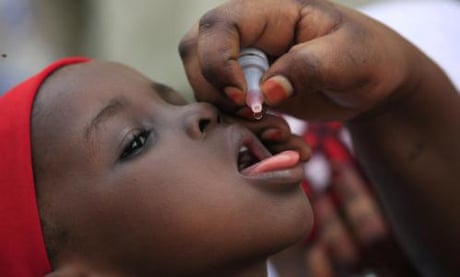John Franklin Enders, a Yale graduate, is known to many as the “Father of Modern Vaccines” due to his integral role in developing both the polio and measles vaccines. Read the full story on Manuscripts and Archives, Yale University Library page: http://campuspress.yale.edu/mssa/
Access the John Franklin Enders collection here: https://archives.yale.edu/repositories/12/resources/4495……
更多

88
3次分享
讚
留言
分享
Polio: An American Story

---
Man found to have been shedding virulent strain of polio for 30 years
Weakened form of polio from childhood immunisations lived on in subject’s gut, mutating into a strain which could cause paralysis in the unvaccinated
 The polio virus. The British man was found to be carrying a form of the virus which had mutated from the weakened form used in vaccines. Photograph: Dennis Kunkel/Microscopy, Inc.
The polio virus. The British man was found to be carrying a form of the virus which had mutated from the weakened form used in vaccines. Photograph: Dennis Kunkel/Microscopy, Inc.Emily Mobley
Thursday 27 August 2015 19.00 BSTLast modified on Friday 28 August 201511.42 BST
A British man with an immune deficiency has been shedding a highly virulent, mutant strain of polio virus for nearly 30 years as a result of childhood vaccinations.
The discovery has prompted scientists to warn of other patients who could unwittingly trigger fresh outbreaks of the disease in regions where people are not sufficiently protected against the illness.

Africa's year free of polio is giant step towards eradication
Read more
Researchers analysed more than 100 stool samples from the man and found mutated versions of the polio virus capable of causing paralysis. They believe he has been shedding the mutated strain for 28 years.
The man had a full course of polio vaccinations, which included three doses of weakened live virus at 5, 7 and 12 months, followed by a booster jab when he was about seven years old. He was later diagnosed with a condition that suppresses the immune system, affecting its ability to kill viruses in his gut.
Tests on the viruses found in the man’s stool samples revealed they had mutated from the weakened form used in the vaccines into a more dangerous strain.
People who are fully vaccinated against polio are not at risk, but in countries where routine vaccination is not encouraged, similar immune-deficient patients could potentially start a new polio outbreak.
The man received the older oral polio vaccine (OPV) that contained a weakened form of the virus, and was often given on a sugar cube. In 2004, the UK switched to an inactivated polio vaccine (IPV) which is injected.
The discovery, reported in the journal Plos Pathogens, has implications for health officials who are close to eradicating polio from the three remaining countries where the virus is still circulating: Pakistan, Afghanistan and Nigeria.
Before the disease can be completely wiped out, mutated strains of polio virus derived from vaccines must be tackled. To that end, the World Health Organisation is set to trial a new vaccine next April.
But work still needs to be done to eradicate polio worldwide, and this discovery of a mutated poliovirus in the UK, among others in Slovakia, Finland and Estonia, presents an extra hurdle before the finish line.
“These viruses could potentially cause poliomyelitis in susceptible people, so it is very important to maintain high levels of vaccine coverage,” said Javier Martin of the UK National Institute for Biological Standards and Control.
“We are working on an end-game strategy,” he added.
沒有留言:
張貼留言